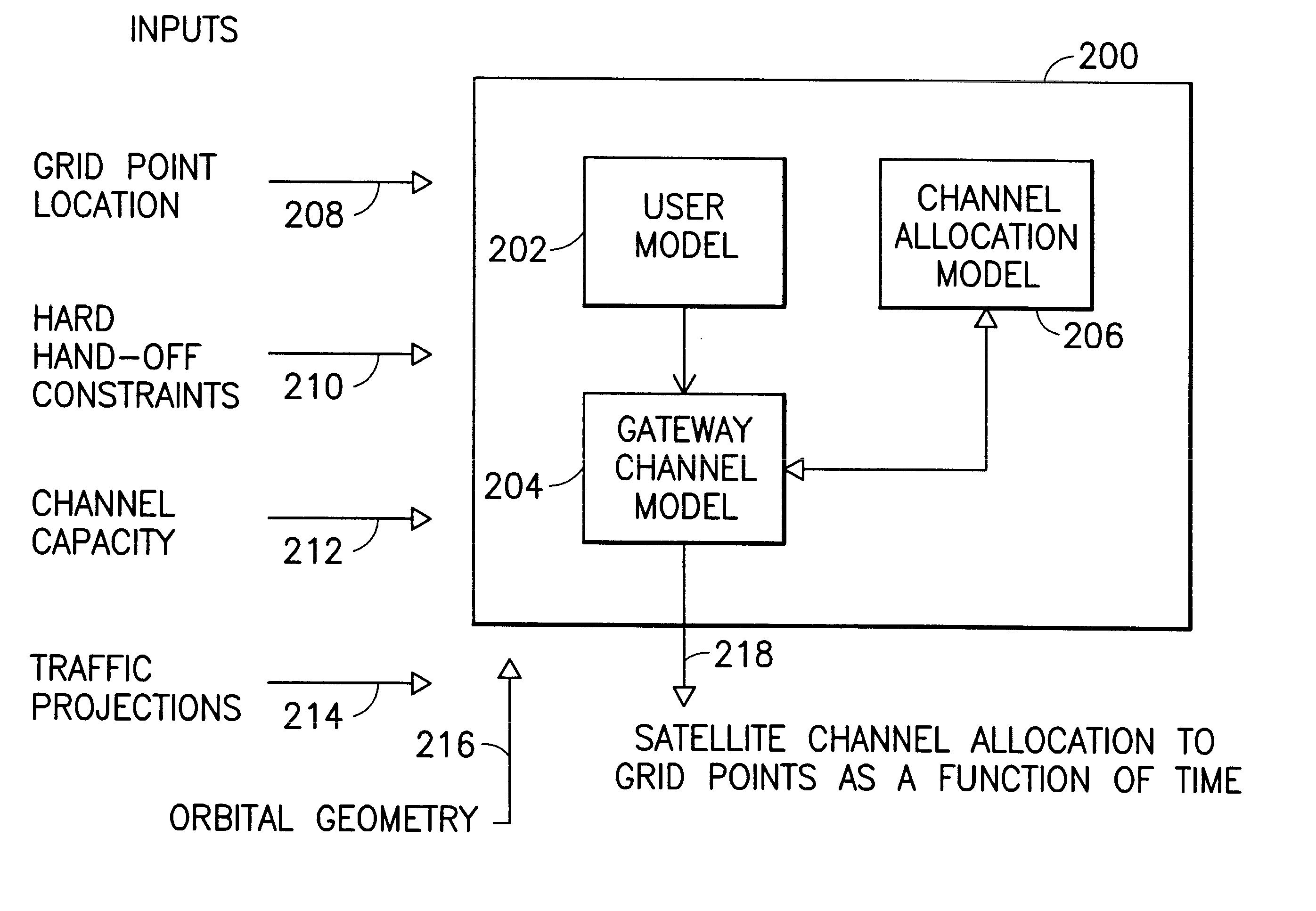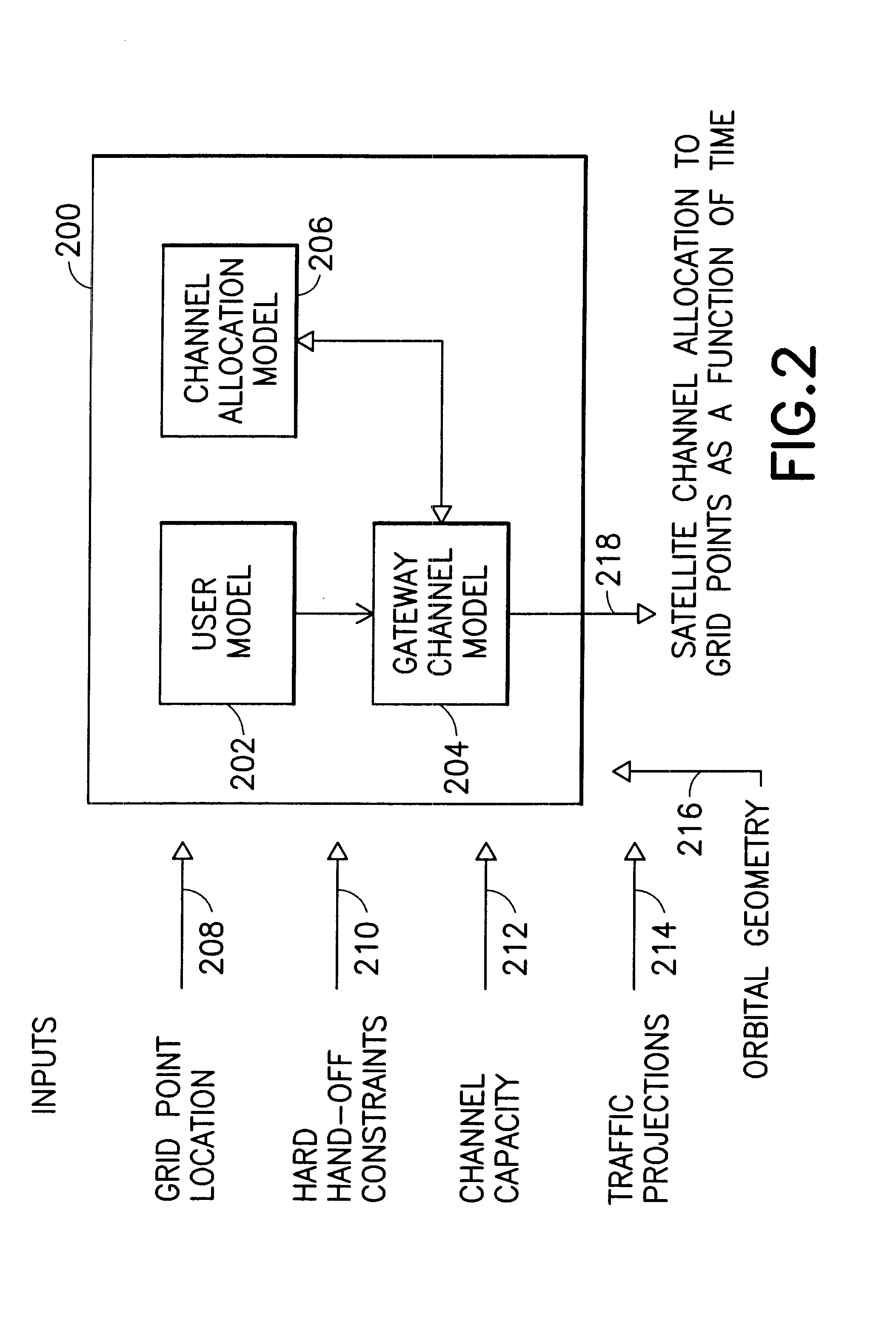The operational CDMA link-capacity of the FDMA channels in these
hybrid systems is affected by
path gain, co-channel interference between FDMA channels and CDMA self-interference within one FDMA channel, among other things.
Moreover, the
usable link-capacity of each satellite-cellular channel is further reduced and complicated by the link diversity required by
satellite motion and by satellite battery-power constraints.
These constraints introduce uncertainty into the allocation of CDMA links in response to user demand.
For example, even for a simple three-gateway region having only two satellites in view, the calculation of actual CDMA link capacity for one FDMA channel consumes two weeks of computing time on a high performance computer system.
However, packet-based TDMA satellite-cellular technology also requires large blocks of contiguous frequencies, blocks that are only available in the weather-sensitive gigahertz frequencies at the high end of the spectrum.
Also, TDMA traffic is
highly sensitive to time
jitter, which necessitates the use of fixed tiling and complex, expensive, error prone "steerable-beam" satellite equipment, to protect the continuity of each link's time base.
The size of cells in FDMA ground-cellular networks is also limited, as a practical matter, by the power that mobile terminals need to transmit back to a
base station, particularly the transmitters of hand-held cellular phones which are limited in power by health and safety concerns as well as battery power.
In satellite cellular networks, the limited power of hand-held units requires the use of transiting, low-earth-
orbit (LEO) satellites, rather than the geostationary satellites (i.e., satellites that can be conveniently fixed at a point in space relative to a point on the earth).
However, this rigid pattern results in some areas being underserved while others nearby have excess capacity, and satellite diversity is not provided.
In general, hard handoffs occur in cellular networks when mobile users move into an adjacent
cell's coverage area.
Thereafter, hard-handoffs from the initial carrier frequency may produce momentary outages or "dropped" calls.
Regardless of the cause, if a user terminal must change channel frequencies while a call is in progress,
noise produced by that change compromises the quality of that call connection.
Channel changes often affect circuit quality by causing a "click"
noise or, worse, an unworkable
frame error rate on a link causing the call to be dropped, either because the error rate produces excess acquisition
delay, or because an excessive SNIR after acquisition has triggered a reassignment of the link by the network.
In either ground-cellular or satellite-cellular networks, if a user terminal is directed to change channels while a call is in progress, additional
noise produced by that change may compromise the quality of that call circuit.
Channel quality during a call is also affected by co-channel interference and
self interference,
fading, shadowing and
signal reflection, as well as by hard and soft handoffs.
In multiple-satellite networks, FDMA / CDMA link allocation is further complicated by the need to dynamically assign channels so that the assignment of channels to gateways is coordinated with satellites' movement as well as that of mobile users.
However, this type of on-board
control system is expensive, complex, and hence, less reliable.
Also, steerable beams require a wasteful, invariant tiling of the earth's surface to maintain consistent beam registration.
Known ground-cellular channel allocation strategies do not provide satisfactory
channel capacity and channel quality for satellite-cellular FDMA /
CDMA networks.
If the action is not timely, it is not effective.
However, the computations required by existing channel-allocation strategies for minimizing satellite self-interference and conserving satellite battery power are too cumbersome for their results to be timely.
Also, satellite self-interference and the need to conserve satellite power both impose constraints on satellite networks' operations that are very different from those encountered in designing ground-cellular networks.
The interference caused by CDMA signals from other satellites using the same channel is co-channel interference.
However, slow power fluctuations in an individual satellites' signals, typically changes lasting several minutes, are characteristic of satellite-cellular networks even when user
traffic volume is constant.
However, the magnitude and duration of these fluctuations may exceed the on-board battery-power that is available for such compensation.
However, when user-
traffic volume is large, conventional allocation strategies may produce suboptimal, wasteful channel assignments, because they make inflexible assumptions.
In particular, employing an arbitrary, fixed value for a satellite's maximum
usable on-board power can unnecessarily limit the number of links available in each channel it transmits.
However, these models are oversimplified.
However, this either / or dichotomy between completely-shared channels and completely-partitioned channels makes it inapplicable to many types of
hybrid networks.
However, since
CDMA channels are "soft", the assumption that a given number of channels is always available makes it unworkable for
CDMA networks.
Greedy algorithm solutions of the allocation problem are also not practical for large, complex multiple-satellite cellular networks because of the computational burden they impose on the network.
However, these techniques are often difficult to scale to real-world
traffic conditions, because they are statically predictable, but non-stationary.
Allocations using
graph theoretic techniques also impose an unacceptably onerous computational burden.
 Login to View More
Login to View More  Login to View More
Login to View More 


